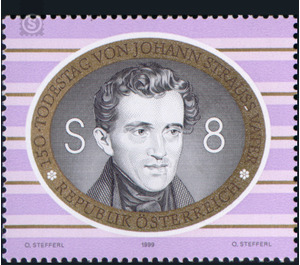150th anniversary of death - Austria / II. Republic of Austria 1999 - 8 Shilling
Theme: Art & Culture
| Country | Austria / II. Republic of Austria |
| Issue Date | 1999 |
| Face Value | 8.00 |
| Printing Type | combination printing |
| Stamp Type | Commemorative |
| Item Type | Stamp |
| Chronological Issue Number | 1629 |
| Chronological Chapter | OOS-OE2 |
| SID | 166369 |
| In 61 Wishlists | |
The supremacy of Vienna as the "city of music" secured by the work of Haydn, Mozart, Beethoven, Schubert, Bruckner and Brahms was not only further confirmed by the Strauss dynasty, but also a new dimension. An all-social music and its most popular form of expression, the waltz, gave Vienna additional flair. The founder of this dynasty, Johann Strauss Vater, born on 14 March 1804 in Vienna, had already been inspired to play the violin as a child by the entertainment musicians who worked in his father's company. While still a bookbinder, he first joined the band of Michael Pamer as a violist, where he met Joseph Lanner. When Lanner enlarged his ensemble, Strauß served as assistant conductor and in 1825 founded his own chapel. In the same year he married Anna Streim. The marriage produced the children Johann, Joseph, Ferdinand, Eduard, Anna and Theresia. The Viennese public conquered Johann Strauss through his concerts in no time and the success in his hometown led him to perform with his band outside of Vienna in many European cities. As a composer, Johann Strauss' father left more than 250 works, with the quadrille, the gallop, the march and the polka being represented alongside the clearly dominating waltz. The best-known titles are "Loreley-Rhine-Sounds", "Sperl", "Sigh Gallop", "Annen-Polka" and the "Radetzky March".


